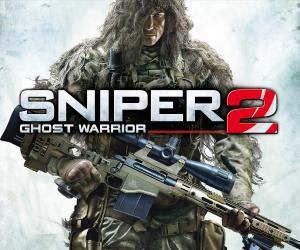 Game: Sniper: Ghost Warrior 2
Game: Sniper: Ghost Warrior 2
Developer: City Interactive
Publisher: Namco Bandai
Available on: Xbox 360, PlayStation 3, Windows PC
Reviewed on: Xbox 360
There’s a lot to be said for freedom in video games, especially in shooters. The freedom to go loud or play it quietly, the freedom to switch between available weapons or pick up an enemy’s, the freedom to mess it all up and improvise to get yourself out of trouble, even the most basic and simple freedom to approach an encounter from a variety of angles and switch up your tactics on the fly. Certain games excel at granting the player such freedom: Halo 4 or Crysis 3 are fantastic examples of games designed to be played.
Sniper: Ghost Warrior 2, from City Interactive, is not such a game. I’m not beginning on a negative here and telling you that it’s necessarily bad; rather, I’m warning you not to go into this experience expecting to be plotting long-range, one-man assaults on enemy bases or ruminating on pre-mission tactics. In Ghost Warrior 2, you are a Sniper, plain and simple, with all the freedom – and, more importantly, all the restrictions – thereof. This is a deliberate design choice, and one that must be embraced before you begin if you’re to avoid bitter disappointment. Ghost Warrior 2 isn’t quite a bare bones sniper experience, but it’s not far off.

STORY: Once again, you’ll find yourself thrust into the rugged boots of series protagonist Captain Cole Anderson, now a “private security consultant” and partnered with veteran spotter Diaz. What begins as a mission to prevent the sale of a powerful biological weapon soon diverges down separate paths that unavoidably evoke unfavourable comparisons to last year’s excellent Call of Duty: Black Ops II, with the whole middle act devoted to backstory that takes place in 1993.
Similarly to Black Ops II’s villain Raul Menendez, Ghost Warrior 2’s Merinov is a character from Anderson’s past, setting up a classic vendetta-driven narrative that ultimately shares only cosmetic elements with David Mason’s story in Treyarch’s superior shooter. Despite one fairly impressive twist, the actual plot of Ghost Warrior 2 is incredibly pedestrian, not to mention predictable and generic. It serves as little more than a vehicle to carry Anderson from mission to mission – but it is, at the very least, an improvement on the first game’s disjointed structure.
The characters are largely stock, from Merinov’s rags-to-riches, scheming villain to Anderson’s noble, sometimes reluctantly-patriotic American hero. He’s a soldier first who just wants to get in and do his job without the politics, and when the machinations of higher powers get in the way he struggles with the choice between following orders and doing the right thing. What should make him interesting instead renders him fairly dull, as he’s basically led through the entire game by the actions and commands of others – most notably Carl Maddox, his more emotive Spotter during the 1993 sections. Maddox is a more compelling character, even if such an accolade does come from him being a bit of an unprofessional douche. Ultimately, the overall plot is playable enough and certainly well acted, but almost instantly forgettable.
GRAPHICS: City Interactive’s biggest leap from the original game to the sequel is a graphical one. The last game was as ugly as sin, with bland environments, uninspiring textures and a flat, unexciting world through which to slink. Ghost Warrior 2 is a hell of a lot better, visually, thanks entirely to the use of the CryEngine 3. While City Interactive don’t reach the aesthetic heights of Crysis 3, Ghost Warrior 2 is still a pretty game to look at with a good use of lighting and a nice variety of locales.
There are issues with the environments themselves, which still occasionally seem lifeless, and the character models aren’t especially detailed, but on the whole the visuals are bright and sharp. Minor glitches occur now and then, specifically when the slow-motion kill-cam is used, but aside from that Ghost Warrior 2 is a decent-looking game.
SOUND: Exactly as expected, the sound in Sniper: Ghost Warrior 2 is nothing special, though there are a few nice touches if you listen closely. For instance, Anderson’s breathing, whether laboured after a long sprint or caught in his throat as you line up a shot, add a degree of atmosphere to proceedings, as does the sound of your heartbeat during tense stand-offs (more noticeable in the multiplayer maps). Rounds being chambered and fired sound the same as any other shooter, as does the wet thwack when a bullet tears a slow-motion hole in a bad guy’s head, but the lack of overly loud action music enhances the ambience considerably.
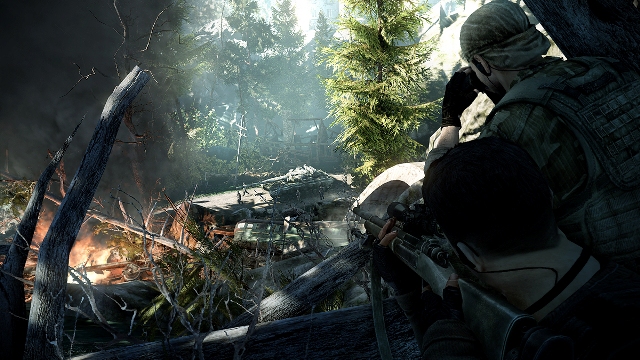
GAMEPLAY: The greatest disappointment in Sniper: Ghost Warrior 2 harkens back to my opening line: You have very little freedom throughout almost the entire game. As Anderson you’ll spend most levels moving through foliage either following someone’s lead, or following someone’s relayed orders, ducking when you’re told to duck, running when you’re told to run, and shooting only when given permission and only at pre-designated targets. In comparison to Rebellion’s Sniper Elite V2, this game feels almost shockingly linear; and V2 was never what you’d call a sandbox.
Usually armed with only your sniper rifle and a silenced pistol, you’ll often begin levels alongside a spotter (either Diaz or Maddox), who will basically order you around for half an hour at a time. You are an instrument, a weapon only, to be aimed and primed and fired at specific targets. It’s simultaneously agreeable (after all, the only thing you can really do to mess things up is miss) and abhorrent (you will be made to feel like a child more than once) as you follow your instructions to the letter to get the job done. Deviate from the plan and, at best, you’ll receive a caution from your CO, at worst you’ll kick off an absolute orgy of incoming bullets and die fairly quickly. Anderson can carry two instant-use medkits, but a few direct hits and you’ll never get the chance to hit the relevant button in time.
Occasionally – but only occasionally – Ghost Warrior 2 lets you have your head, and it’s in these brief moments that you’re given a glimpse of the potential buried under all the hand-holding and signposting as you’re left to your own devices. You get to choose who to kill and which weapon to do it with; you get to play around with positioning, lining up shots to score double or triple takedowns. You can shoot a nearby wall to attract attention or even try and take everyone out with just your combat knife. But these moments are fleeting, and the rest of the time the game will actively tease you with mouth-watering tastes of what could be. For example, you might be commanded to shoot a radio to distract an idling guard, or sneak through an area to find a junction box and shut off the lights, plunging everyone into darkness while you calmly activate your night-vision goggles – but these events are scripted rigidly into certain missions and often only occur once in an entire playthrough. Even the vehicle sections are tightly controlled and short-lived.
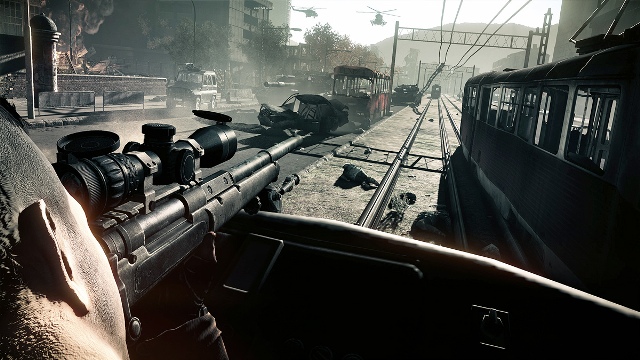
On the one hand it’s an understandable design choice, and one that you simply have to accept if you want to get the most out of Ghost Warrior 2: City Interactive are aiming for an authentic sniping experience. This is not a one-man war against a vast army, or the tale of one plucky soldier stranded behind enemy lines with only your rifle and your do-or-die attitude – you are a military sniper, highly-trained to take orders, to listen to your Spotter and trust him, to point and shoot and remove threats to national and global security. The idea of running wild and conducting yourself like Arnie on a bad day goes against everything a sniper stands for and so, in that respect, City Interactive have hamstrung themselves with their subject matter. But on the other hand, this is a game, and as such you expect – nay, demand – that certain liberties be taken. You want for nothing more than the game to say, “Here’s your rifle, here’s some C4, here’s a pistol and a knife – now find a vantage point, cause a distraction and kill the living shit out of everyone wearing a different colour to you.” But it doesn’t ever do that, and that is the great shame.
Bearing that in mind, Ghost Warrior 2 is nowhere near a complete failure. In fact, it can be very enjoyable when you get past your initial downer. For a start, the shooting itself is excellent. Realistic ballistics mean that everything affects the trajectory of your shot: Your elevation and distance from target as well as the direction and speed of the wind factor into every pull of the trigger. On the first two difficulty settings, a tiny red dot will appear around the crosshair if you hold a target for long enough or make Anderson hold his breath to steady his hand. This dot shows you where the bullet will actually hit in relation to the crosshair – playing on the highest difficulty disables it, calling for absolute concentration and a real understanding of ballistic physics to hit any long-range target. I tried it for about ten minutes before giving up due a complete lack of patience – but I daresay some players will relish the challenge and learn to make use of the info printed at the top of the screen to accurately adjust their aim and play a much purer game.
Anderson’s movement around the environment is assured and weighty, adding a level of realism that heightens tension. Sprinting for cover as the red circle around your radar grows to indicate that you’re on the cusp of being spotted, before dropping into a prone position in the nick of time feels great, as does the sense of dread as you hide under a truck or behind a swaying fern as a column of soldiers walk by. And just wait until you get a squad with a German Shepard in its midst, sniffing you out and kicking it off no matter how well hidden you are. Again, the moment is scripted, but it’s a great moment nonetheless. Clearing an area will usually reward you with a slow-motion, bullet-tracking kill-cam shot (sadly not in X-Ray vision) that shows off your kill in gory detail. Thankfully, it’s not overused and always looks fairly cool.
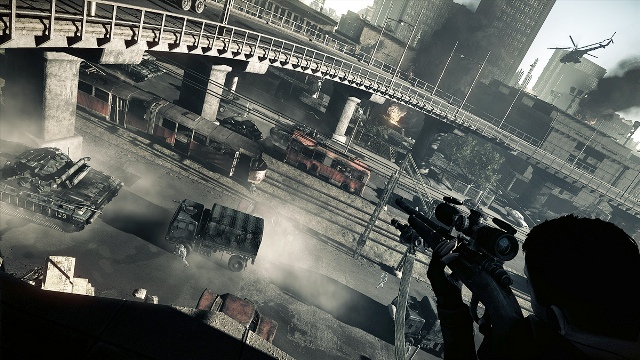
Quite often, a mission will involve you following orders to sneak your way to a vantage point before setting up shop to finish the level with a set-piece of some kind. The set-piece itself varies quite a bit, from covering a Special Forces team as they attempt to free a hostage to picking off individual guards so that a PoW can escape. A particularly stand-out mission involves Anderson escaping from a bunker he’s incarcerated in, armed with only a silenced pistol. Interestingly, the pistol is as deadly up close as the sniper rifle is at range. In a rare move for an FPS, Ghost Warrior 2 recognises that a bullet is a bullet, and shooting someone with a pistol is just as lethal as with a shotgun. It’s a nice touch and somehow makes things seem that little bit more real.
Unfortunately, the A.I. is incredibly hit-and-miss. Sometimes a guard will see you through a brick wall, and at other times you can stand in front of one with your trousers unzipped and he won’t bat an eyelid. Also, enemies are often set to charge, meaning you’ll often find yourself without sufficient time to even switch to your pistol before they’re in front of you, gunning you down. It’s infuriating, but at least the checkpoint system is just generous enough that you won’t ever be forced to replay vast sections of a mission.
As a minor aside, it should be said that the fact that Ghost Warrior 2’s most annoying bugbear is one that appears in every single shooter ever makes it no less irritating: Anderson is a trained, elite sniper with twenty years’ experience in the field – so why in God’s name can’t he keep his hands steady without holding his breath? I get that an elevated heartbeat (which is also monitored on the HUD) will affect concentration and motor skills, but the man has been shot at a lot, and clearly has a genuine, natural-born talent for long-distance head-popping – so why does he shake like a geriatric on a tumble dryer when you try to line up a shot while standing on both feet?
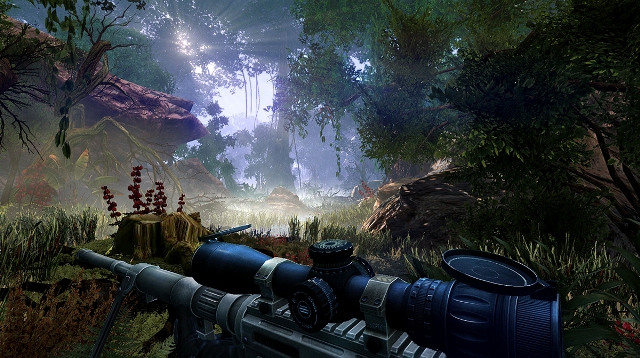
MULTIPLAYER: The multiplayer element of Sniper: Ghost Warrior 2 is spartan, to say the least. A paltry two maps (that’s two) and one game mode (yes, one) is hardly going to trouble the likes of CoD and Halo, nor is the lack of customisation options. You can’t even mute mic chatter. All you get is your guy and a choice of rifle which, while not entirely cosmetic, don’t differ all that much from one another.
The servers are diabolical, too. It took me six attempts to finally get into a game, and even though I was informed over and over that the servers were full (really?), I played three games in a row without a full pair of teams. It’s almost not worth including the mode on the disc, it’s that barren. Ten years ago, it would have been acceptable, but multiplayer gaming has come so far that it really, really isn’t good enough anymore to supply an online element that is so sparse in content. However, when you actually play it, it begins to make sense very quickly because, despite the lack of variety and imagination, it’s incredibly fun. Sprinting to a hiding place, hunkering down and scanning the opposite side of the map for any telltale sign of movement is tense and addictive – and finally getting a bead on a player who doesn’t even know you’re there and popping one in his head is one of the most immediate buzzes I’ve ever experienced in a multiplayer game – closely followed by sprinting away from a compromised cover position as high velocity rounds tear through the air beside you.
City Interactive have promised free DLC in the coming months that will include two new modes and a couple of extra maps, which will be great, but if these extras had shipped with the disc I might be giving it a higher score. As it stands, Ghost Warrior 2’s multiplayer is a disappointing dichotomy, because what City Interactive have given us is great fun – there’s just so little of it that it almost feels like an insult.
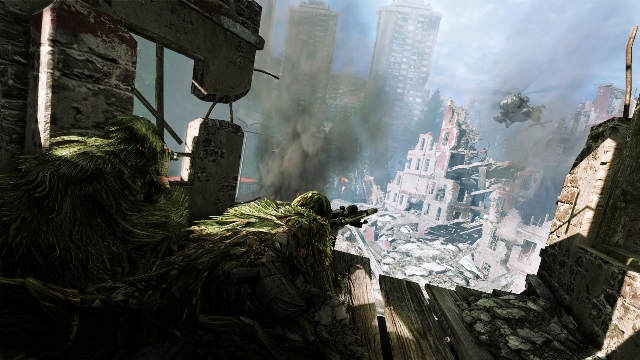
LONGEVITY: Sniper: Ghost Warrior 2’s campaign will take you around six hours from start to finish, longer if you play on a tougher difficulty and have to take your time with every single shot. There are collectible secrets scattered around each level, such as Hula-girl statuettes and film reels, but there’s little real incentive to go looking for them. Such is the linear nature of each level, however, that you’ll rarely have to wander far off the beaten path. Shooting ranges give you a chance to practice outside of the main campaign, but they’re incredibly limited and, really, not a lot of fun at all. Until the multiplayer is expanded, there’s little happening online to keep you returning, and so it’s likely that you’ll be done with Ghost Warrior 2 in no time at all.
VERDICT: City Interactive’s sequel is a game at war with itself. It desperately wants you to go out and have fun blasting bad guys away, but presents the opportunities to do so under such a rigid set of rules and orders that, at certain moments, it might as well be on rails. That said, it’s a huge improvement on the original, not just graphically but in terms of story and gameplay, too. If you were allowed just a little more freedom to approach objectives in your own way, there’d be heaps of replayability here, but as it stands you can see everything there is to see in one playthrough and never have to adjust your tactics once.
An exhilarating but creatively-bankrupt multiplayer, a well-written but ultimately pedestrian narrative, and a potential sandbox of long-range assassination that never manages to become a reality – Sniper: Ghost Warrior 2 is a solid sniper sim when it’s being a sniper sim, but at all other times it’s just a little bit underwhelming.






